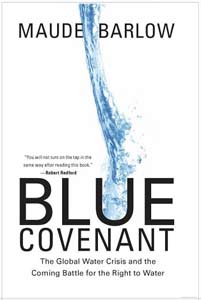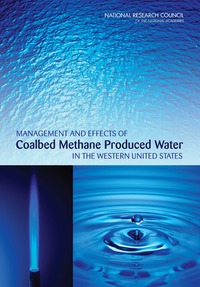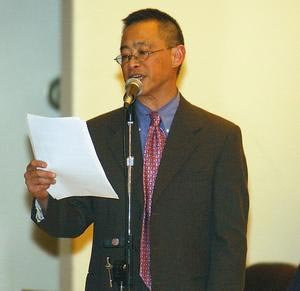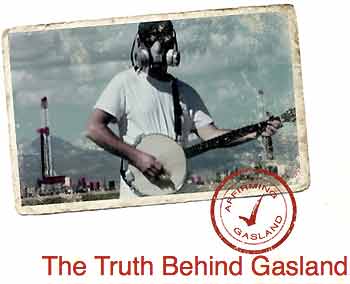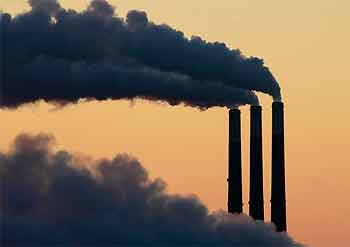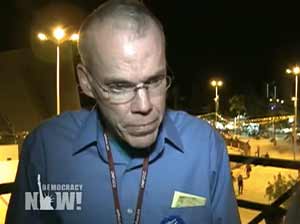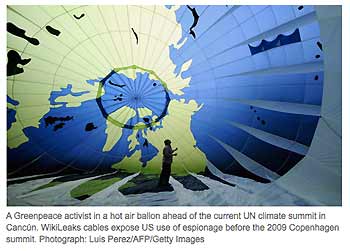Contains the keyword experts
This is an expert's view of our worldwide water crisis. References to facts are found in the back of the book making for an uncluttered read in language everyone can understand. Follow some of the stories about the World Bank and many other reversals of corporate efforts to privatize what ought to be a basic human right: clean water.
Hydraulic fracturing uses five million gallons per well with tens of thousands of wells planned for the Marcellus Shale. Water resources in "shale plays" are already threatened by mining operations and weak environmental justice. These invaluable resources need public protection. Volunteer regulation does not work.
See: Maude Barlow. Feb. 25, 2008. Foreign Policy In Focus. "The Global Water Crisis and the Coming Battle for the Right to Water."
See: Amy Goodman and Juan Gonzalez. "From Melting Glaciers to Structural Adjustment: Maude Barlow on the Need for Water Justice." Democracy Now! April 22, 2010.
See: Flow - The War Between Public Health and Private Interests
See: WATER: Rulings Restrict Clean Water Act, Foiling E.P.A.
This booklet provides an introduction to drinking water issues. It draws from a body of independent, peer-reviewed expert consensus reports from the National Research Council to provide an overview of public water supply and demand, water management and conservation, options for the government and the private sector, and the economic and ecological
aspects of drinking water.
See the Division of Earth and Life Studies.
Key Finding
Authoring Organizations
Visit Toxics Targeting for more information.
Ignitable Drinking Water From a Well in Candor, New York, Located Above the Marcellus Shale Formation (Spill #: 0811696)
See Walter Hang's letter to NYS DEC Commissioner Pete Grannis, 4/2/10.
Colorado School of Mines has estimated the amount of gas that might be developed in the U.S. Golden, Colorado, June 18, 2009. See also: U.S Energy Information Administration. (2009). Annual Energy Outlook Early Release Overview.
The New York-based Toxics Targeting went through the Department of Environmental Conservation’s own database of hazardous substances spills over the past thirty years.
They found 270 cases documenting fires, explosions, wastewater spills, well contamination and ecological damage related to gas drilling.
Derrick Ek. "Gas drilling concerns aired at DEC hearing," Nov 19, 2009. Corning Leader.
Ithaca environmental activist Walter Hang details a history of problems caused by the oil and gas industry in New York State.
Our analysis suggests that while shale gas development poses significant risks to the environment, including faulty well construction, blowouts, and above-ground contamination due to leaks and spills of fracturing fluids and waste water, technologies and best practices exist that can help manage these risks.
Best practices are currently being applied by some producers in some locations, but not by all producers in all locations. Enforcing strong regulations is necessary to ensure broader adoption of these practices and to minimize risk to the environment. In addition, if increased shale gas development is to be undertaken responsibly, the cumulative risks of developing thousands of wells must be considered.
The report concludes that faulty well construction, in particular poorly cemented steel casings needed to isolate the gas from shallow formations, as well as above-ground contamination due to leaks and spills of fracturing fluids and waste water, pose more significant risks to the environment.
In addition, continued study and improved communication of the environmental risks associated with both individual wells and large scale shale gas development are essential for society to make well-informed decisions about its energy future.
"Although the technologies, best practices, and regulations that can help minimize these risks exist, they have not yet been universally adopted," says Worldwatch Fellow and co-author Saya Kitasei. "Experiences in Colorado, Wyoming, Pennsylvania, and New York demonstrate that strong public pressure exists for stricter oversight."
Mark Zoback is one of the scientists on the short list for the upcoming EPA study.
The Worldwatch Institute is an independent research organization recognized by opinion leaders around the world for its accessible, fact-based analysis of critical global issues. The Institute's three main program areas include Climate & Energy, Food & Agriculture, and the Green Economy.
See: Flavin, C., and S. Kitasei. The Role of Natural Gas in a Low-Carbon Energy Economy. Briefing paper. Natural Gas and Sustainable Energy Initiative. Washington, D.C.: Worldwatch Institute, 2010. (PDF, 617kb)
From Sourcewatch:
Immediately upon the film's release, Energy In Depth issued a paper claiming to "debunk" the film's documentary evidence.
Energy in Depth (EID) is a pro-oil-and-gas drilling industry front group formed by the American Petroleum Institute, the Petroleum Association of America and dozens of additional industry organizations for the purpose of denouncing the FRAC Act proposed by Colorado U.S. Rep. Diana DeGette to regulate underground fracking fluids.
EID has crafted an entire campaign to delegitimize Fox's film, coining itself "Debunking Gasland." Many Facebook and Google users have even reported "Debunking Gasland" ads popping up on those respective websites.
Josh Fox has responded to every claim in "Debunking Gasland" put forth by Energy In Depth in a piece titled "Affirming Gasland."
History of regulating hydraulic fracturing under the Safe Drinking Water Act (SDWA)
From Affirming Gasland, "Supplemental Reading Section", p. 24.
The Safe Drinking Water Act requires EPA to promulgate regulations for states to administer these provisions of the law in order to protect underground sources of drinking water. However, although the SDWA gave the EPA the authority to regulate underground injection practices, Congress also directed that the EPA should not prescribe unnecessary regulation on oil- and gas- related injection.
Therefore, after the Safe Drinking Water Act passed, the EPA erroneously took the position that hydraulic fracturing did not fall within the regulatory definition of underground injection as provided in the Act.
In 1997 the 11th Circuit Court of Appeals laid the matter to rest when it conclusively ruled in LEAF v EPA, 118 F.3d 1467 (11th Cir. 1997) that hydraulic fracturing activities constituted “underground injection” under Part C of the SDWA.
As a result of the court’s ruling, in 1999 the state of Alabama amended its rules and made hydrofracking subject to the provisions of Part C of the SDWA by requiring Class II permits for each hydrofracking well.
Cheney’s Halliburton (a prime developer and leading practitioner of hydraulic fracturing) began lobbying Washington to exempt fracturing from regulation under the Safe Drinking Water Act.
Then in 2001, during his second week in office, George W. Bush created the Energy Task Force, with Vice President Dick Cheney as chairman. The mission of the task force aimed to “develop a national energy policy designed to help the private sector.” Its final report included a recommendation to exempt fracturing from regulation. Cheney removed the exemption from the draft only after being pressed by EPA chief Christie Whitman.
The exemption surfaced again in the Bush/Cheney Energy Bill of 2003 which did not pass, and reemerged one final time, in the Energy Policy Act of 2005, thanks, in part, to the efforts of Congressmen James Inhofe of Oklahoma and Joe Barton of Texas. To avoid the effect of the ruling in LEAF v EPA, Sec 322 of the Act specifically provides that the term “underground injection” excludes the underground injection of fluids pursuant to hydraulic fracturing operations related to oil, gas, or geothermal production activities. This clause from the law is actually photographed in Gasland at 31:42.
The 2005 Energy Policy Act also altered the Clean Water Act stormwater provisions. Pub.L. No. 109-58, § 323, 119 Stat. 694 (codified as amended at 33 U.S.C. § 1362(24). Section 323 modified the Clean Water Act's definition of an oil and gas exploration and production activity to include oil and gas construction activities. Because the Clean Water Act mandates that the EPA not require a stormwater permit for oil and gas exploration and production activities, it has been argued that the change in the Energy Policy Act of 2005 excluded oil and gas construction activities from stormwater permit coverage, without regard of the size of acreage disturbed.
Previous laws exempted oil and gas drilling, known as oil and gas exploration and production, from Superfund (CERCLA) and RCRA (hazardous waste). CERCLA includes substances that are elements of petroleum as hazardous in Section 101(14), yet crude oil and petroleum are specifically exempt from coverage under the last clause of the section. Thus, hazardous chemicals that would otherwise fall under the ambit of CERCLA are immune from the statute when encompassed in petroleum or crude oil. Likewise, the Solid Waste Disposal Act (SWDA) of 1980 exempted oil field wastes from Subtitle C of the RCRA.
Oil and gas drilling is not typically covered by Clean Air Act permitting since EPA’s CAA regulations do not allow EPA to aggregate or group a set of wells as a single source of air emissions. EPA has proposed rules that if promulgated would allow EPA and the states to aggregate air emissions coming from one company when the facilities are connected to one set of piping.
Some oil and gas machines emit large enough air emissions to be subject to air permit requirements, for example gas dehydradation units emitting over 10 tons per year of volatile organic compounds (VOCs) and gas compressions engines emitting over 50 tons of NOx per year.
However, the industry remains mostly unregulated under this statute by using many smaller compressors and dehydrators which individually emit less VOCs than the limits. If these units were to be aggregated and counted as one larger source (which they should be, in our view) the regulations would be in effect. In addition, neither the diesel engines used to drill nor the volatiles that come off the reserve pits are subject to CAA permit regulations.
For a more complete list of these exemptions please see the following websites:
Earthworks. (2007). "The Oil and Gas Industry’s Exclusions and Exemptions to Major Environmental Statutes."
NRDC. (2007). "Drilling Down: Protecting Western Communities from the Health and Environmental Effects of Oil and Gas Production."
NRDC. (2007). "Toxic Oil and Gas Production Gets a Free Pass to Pollute."
The Energy Policy Act negated the effect of the Alabama LEAF case by expressly defining HF as not subject to the SDWA, provided that HF fluids did not contain diesel; HF that contains diesel remains subject to SDWA limitations.
See: IADC. "Alabama lawsuit poses threat to hydraulic fracturing across U.S." Drilling Contractor. Jan/Feb. 2000.
See: Gasland vs Big Oil and Gas
See: Gasland - The Debate
See: Bushwhacked : Life in George W. Bush's America
See: U.S. Environmental Protection Agency (EPA): Hydraulic Fracturing Study (2010-2012)
Hundreds of millions of dollars in grants from major oil companies may have compromised the ethics of energy research at such institutions as UC Berkeley, UC Davis, Stanford and Cornell.
Cornell is considering leasing some of its land holdings to natural gas drillers. SUNY Binghamton signed a $1.4 million dollar gas lease in 2008.
See: Editorial - A Decision Above Reproach | The Cornell Daily Sun.
See: Lee Fuller. "HF 101: As Cornell Begins Study of Shale Gas Exploration, Energy In Depth Offers Itself Up as Resource for Ad Hoc Panel". Energy in Depth.
Read the full report here:
According to the 212-page study, released by the Center for American Progress, a Washington-based think tank, such companies as BP, Chevron, and ConocoPhillips have funded more than $800 million in potentially compromised research with few protections for academic independence.
For example, since 2002, Stanford has received $225 million from a consortium led by ExxonMobil to study technology to curb greenhouse gas emissions. The company operates refineries, oil drilling facilities, tankers and gas stations, making it a major emitter of carbon dioxide and other greenhouse gases globally.
As part of the Stanford contract, the industry controls all four voting seats on the research alliance's governing body, and peer review of faculty research proposals is done "at the discretion of industry sponsors," the report says.
...this report represents the first time independent analysts have systematically examined a set of written university-industry agreements within a specific research area—in this case, the energy R&D sector—to evaluate how well they balance the goals of the corporate sponsors to produce commercial research that advances business profits with the missions of American universities to perform high-quality, disinterested academic research that advances public knowledge for the betterment of society.
See: GCEP Director Sally M. Benson responds to Center for American Progress report: More
See: DemocracyNow!: Big Oil Goes to College: BP, ExxonMobil, Chevron, Shell Fund & Influence Research at Major Universities
See: DemocracyNow! Transcript on truth-out.org.
See: Helene Cooper and John M. Broder. "BP’s Ties to Agency Are Long and Complex". May 26, 2010. NYT.
Hopefully, this NYT “mention” will draw some much-needed media attention to the actual contents of my own report, which examines university-industry alliances to finance energy research on campus, and raises questions about whether the current structure of these alliances adequately protects the universities’ academic mission and their ability to carry out independent, high-quality, reliable, public-good research. This article today does not address these issues at all. But, helpfully, Cooper and Broder in their NYT story did note that BP, in a May 24th press release, has pledged $500 million for “Independent Research into Impact of Spill on Marine Environment,” with the first grants going to the University of Louisiana. It looks like the iron is hot to look more deeply at university-industry research partnerships of this kind. – Jennifer
Media reports indicate the University of California system may be on the verge of signing a contract to create the proposed Energy Biosciences Institute (EBI) with BP. It is obviously a matter of urgent priority for the health of the planet to promote research and innovation related to alternative energy, and it is imperative that public research institutions direct major new resources to such endeavors. It is not at all obvious, however, that public institutions should do this in collaboration with giant oil companies that are contributing massively to climate change.
At minimum, such collaborations require intense scrutiny and informed debate. The prospect of giant carbon polluters directing research related to and gaining control of key energy technologies is very troubling -- especially when the research is conducted at, and the technologies are developed in collaboration with, public institutions. In this regard, the details of the UC-BP research agreement are of great importance. They will specify how research priorities are to be established, and how the fruits of the research collaborationare to be managed and controlled.
See: LSU News. June 15, 2010. "LSU Receives $5 Million From BP to Fund Spill-Related Research Grant to support studies in everything from human and environmental impact to engineering solutions".
The funds will come from BP’s $500 million Gulf of Mexico Research Initiative, or GRI, which will support universities in the Gulf area in research on the fate and effects of oil, dispersed oil and dispersants.
Silhouetted against the sky at dusk, excess steam, along with non-scrubbed pollutants, spew from the smokestacks at Westar Energy's Jeffrey Energy Center coal-fired power plant near St. Marys, Kan. Credit: AP Photo/Charlie Riedel.
In the name of job creation and clean energy, the Obama administration has doled out billions of dollars in stimulus money to some of the nation’s biggest polluters and granted them sweeping exemptions from the most basic form of environmental oversight, a Center for Public Integrity investigation has found.
The administration has awarded more than 179,000 “categorical exclusions” to stimulus projects funded by federal agencies, freeing those projects from review under the National Environmental Policy Act, or NEPA. Coal-burning utilities like Westar Energy and Duke Energy, chemical manufacturer DuPont, and ethanol maker Didion Milling are among the firms with histories of serious environmental violations that have won blanket NEPA exemptions...
...Documents obtained by the Center show the administration has devised a speedy review process that relies on voluntary disclosures by companies to determine whether stimulus projects pose environmental harm. Corporate polluters often omitted mention of health, safety, and environmental violations from their applications.
Related Stories:
NEPA Exemptions: The Dirty Dozen List
Wisconsin Firm Receives Energy Grant Despite Chronic Pollution Problems
See: Pollution in Your Community | Scorecard
See: A Life’s Value May Depend on the Agency, but It’s Rising
See: Climate Co-benefits and Child Mortality Wedges
See: U.S. Environmental Protection Agency (EPA): Hydraulic Fracturing Study (2010-2012)
Democracy Now! caught up with McKibben at the Cancún Climate Conference in Mexico. We asked for his reaction to the diplomatic cables released by WikiLeaks showing how the U.S. manipulated last year’s climate talks in Cancún.
Some of the new data [Wikileaks] coming out today makes it clear that everyone’s suspicion that the U.S. was both bullying and buying countries into endorsing their do-little position on climate were even sort of worse than we had realized...
...They [The U.S. Congress] think because they can change the tax code, they can change the laws of nature...
...this U.N. process, has been going on forever, and it’s getting nowhere, and it’s not going to get anywhere substantive, until we have some power from the outside to push it.
"It’s just like a family reunion aboard the Titanic, you know?" And that’s sort of what it feels like. We can’t keep doing this. Until we can build some power outside of these arenas to actually push these guys, you know, this is—in the end, it’s not about how well people are communicating or how great the policy papers are. It’s on who has the power. And at the moment, that power rests in the hands of the fossil fuel industry and their allies in governments around the world.
And until we build some independent outside movement power to push back, then we’re never going to get—we’re going to get scraps from the table, at the very best.
See: Damian Carrington. "WikiLeaks cables reveal how US manipulated climate accord." The Guardian.co.uk. 2010-12-03.
See: Ian Traynor. "WikiLeaks cables: Cancún climate talks doomed to fail, says EU president." The Guardian.co.uk. 2010-12-03.





